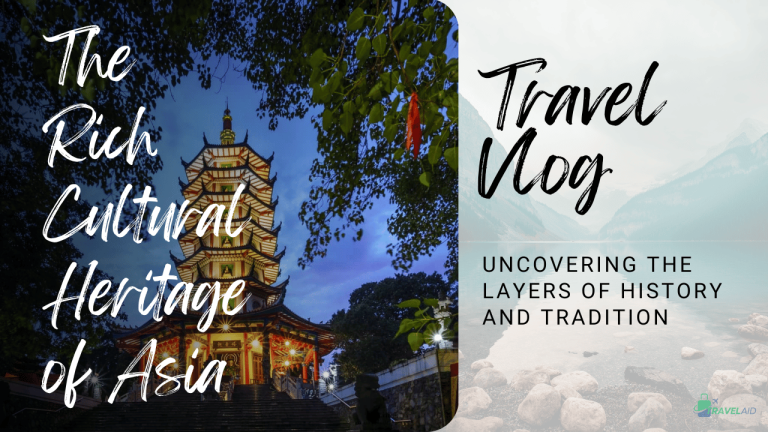Asia is a continent steeped in rich cultural heritage, with each country boasting its own unique history and traditions. From the vibrant colors of India to the serene temples of Japan, there is no shortage of wonders waiting to be uncovered. Join us as we delve deep into the layers of history and tradition that make Asia truly one-of-a-kind. Get ready to be mesmerized by the beauty and complexity of this diverse continent like never before!

Introduction to Asia’s Cultural Heritage
Welcome to a journey through Asia’s rich tapestry of cultural heritage, where history and tradition intertwine to create a mesmerizing mosaic of diversity. Each country in Asia boasts its own unique history and traditions, from the vibrant colors of India to the serene temples of Japan. Join us as we delve deep into the layers of history and tradition that make Asia truly one-of-a-kind. Get ready to be mesmerized by the beauty and complexity of this diverse continent like never before!
The Influence of Ancient Civilizations on Modern-Day Asia
The rich tapestry of Asia’s cultural heritage intricately weaves together ancient civilizations that have left a lasting imprint on the region. Remnants such as the majestic ruins of Angkor Wat in Cambodia and the intricate terracotta warriors in China speak volumes about the advanced societies that once thrived across Asia.
These ancient civilizations have influenced not only architecture but also art, language, and traditions passed down through generations. The philosophies of Confucianism and Buddhism continue to shape societal norms and values in many Asian countries.
In modern-day Asia, age-old traditions seamlessly merge with technology, creating a unique blend of past and present. From bustling metropolises adorned with skyscrapers to serene temples nestled amidst lush greenery, the juxtaposition is striking and harmonious.
As travelers navigate through the bustling streets and tranquil landscapes of Asia, they are reminded at every turn of the enduring legacy left behind by ancient civilizations. Exploring Asia becomes a truly enriching experience for those seeking to uncover layers of history and tradition, thanks to this seamless integration of old and new.
Diversity of Cultures and Traditions in Asia
Asia, a continent rich in history and diversity, is a tapestry of cultures and traditions woven together over centuries. Each country in Asia boasts its own vibrant festivals and graceful ceremonies that reflect its unique heritage.
For instance, in China, calligraphy is revered as a form of expression, while Thailand celebrates Songkran with water fights symbolizing cleansing and renewal. The intricate designs of Korean hanboks reflect both elegance and tradition.

In Indonesia, the sounds of gamelan music resonate through ancient temples, while Vietnam’s Tet celebrations honor ancestors with offerings and prayers. Each region holds its customs close to heart, passing them down through generations.
From the nomadic tribes of Mongolia to the indigenous communities in Malaysia, Asia’s diverse cultures offer a glimpse into humanity’s shared past and future.
Iconic Landmarks and Monuments in Asia
Asia is a treasure trove of iconic landmarks and monuments that stand as testaments to the region’s rich history and cultural heritage. Each site tells a unique story waiting to be discovered, from the majestic Great Wall of China winding its way through rugged landscapes to the serene beauty of Japan’s historic temples.

The awe-inspiring Taj Mahal in India leaves visitors spellbound with its intricate marble design, while the Angkor Wat complex in Cambodia showcases the grandeur of ancient Khmer architecture. The mystical Borobudur Temple in Indonesia is a spiritual pilgrimage site surrounded by lush greenery, offering a sense of tranquility amidst its intricate stone carvings.
The towering Petronas Twin Towers in Malaysia symbolize modernity and innovation, juxtaposed against traditional sites like South Korea’s Gyeongbokgung Palace steeped in centuries-old history. Asia truly offers a diverse tapestry of landmarks and monuments waiting to be explored and appreciated.
Traditional Arts and Crafts in Asia
Asia is a treasure trove of traditional arts and crafts passed down through generations, each telling a story of history and culture. From intricate pottery to delicate silk embroidery, these crafts showcase the remarkable skills of Asian artisans.

In Japan, the art of origami transforms simple paper into elaborate sculptures with just a few folds. The meticulous attention to detail in Chinese calligraphy reflects the country’s reverence for written language as an art form.
India’s rich tapestry of textiles showcases vibrant colors and intricate patterns woven with skilled hands, while batik from Indonesia utilizes wax-resist dyeing techniques to create stunning fabrics with unique designs.
The craftsmanship seen in Korean ceramics demonstrates precision and elegance, while Thailand’s hand-carved woodwork displays exceptional skill and creativity. Each piece created carries the essence of its cultural heritage, making Asian arts and crafts truly remarkable.
Festivals and Celebrations Across Asia
Asia is a vibrant tapestry of diverse cultures and traditions, each woven with the threads of unique festivals and celebrations that bring communities together in joyous harmony. From the colorful Holi festival in India to the mesmerizing Lantern Festival in China, there is no shortage of spectacular events across the continent.
In Japan, cherry blossom festivals symbolize renewal and beauty as delicate pink petals blanket the landscapes in a breathtaking display. Thailand’s Songkran water festival marks the Thai New Year with lively water fights and traditional rituals honoring ancestors.
In South Korea, Chuseok celebrates bountiful harvests with feasts and ancestral rites, while Indonesia’s Baliem Valley Festival showcases tribal dances and rituals steeped in ancient customs. These festivities offer a glimpse into the rich tapestry of Asian heritage, where past meets present in a kaleidoscope of colors and traditions.
Preservation Efforts and Challenges for Asian Heritage Sites
Preserving Asia’s rich cultural heritage is a delicate balance between showcasing its historical significance and safeguarding it for future generations. These heritage sites face various challenges, from natural disasters to urban development, which require innovative solutions.
One major challenge is finding the resources needed to maintain these ancient structures. Many heritage sites struggle with limited funding for conservation efforts, leading to deterioration over time. Additionally, rapid tourism growth can put a strain on these fragile locations, causing wear and tear that requires constant monitoring.
Efforts to preserve Asian heritage sites involve collaboration between governments, local communities, and international organizations. Strict regulations and guidelines are put in place to ensure responsible management of these valuable cultural assets. Education plays a crucial role in raising awareness about the importance of preserving these historical landmarks.
Despite the challenges ahead, dedicated individuals continue their tireless efforts to protect and conserve Asia’s diverse cultural heritage for generations to come.






